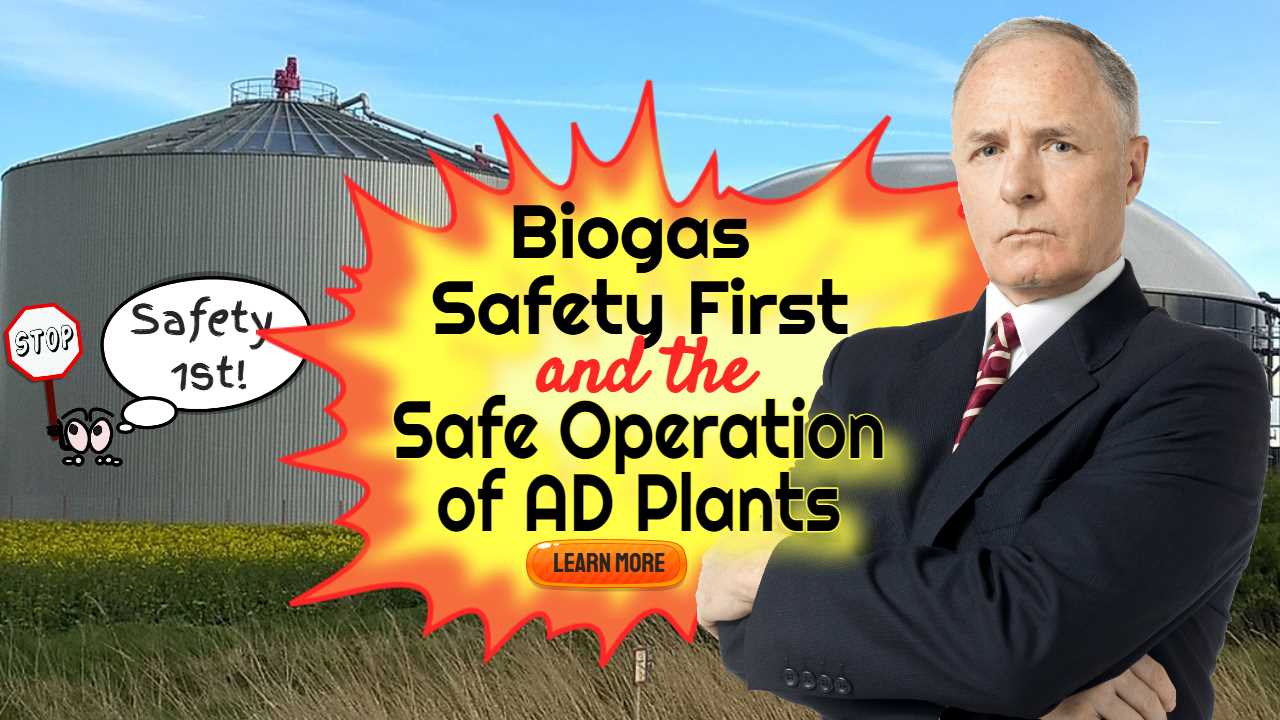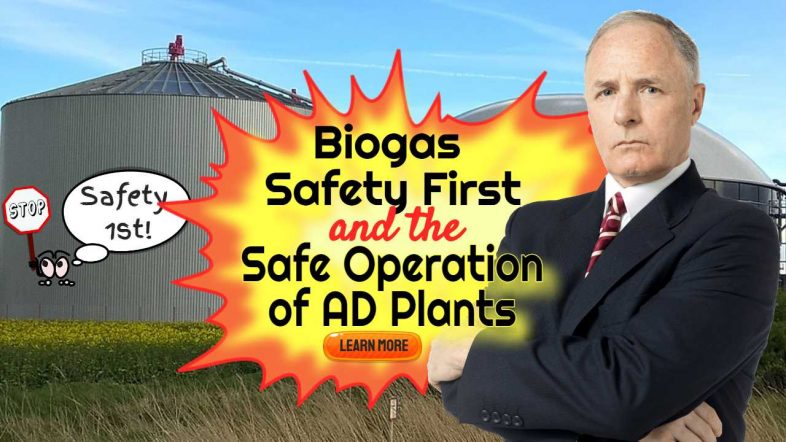Renewable energy sources are much needed, but the presence of explosive gases and potentially also pathogens means that observing biogas “Safety First” and ensuring the “Safety of Biogas/ AD/ Anaerobic Digestion Plants” must rank above simply producing valuable energy.
Watch the video below which we made to give you a quick summary of the main points of this article:

Here we are going to discuss the special health and safety hazards of biogas plants, and how they are ameliorated. This is a vital subject as biogas plants are increasing in numbers, more people are setting up new plants using these bioresources, and the potential for harm to operatives is rising.
The materials which can be used to produce biogas include the biomass from agricultural and forestry residues and domestic waste etc., and it all needs to be done safely. 4 people died in the UK due to a biogas related explosion in the UK, in the autumn of 2020. Putting Biogas Safety First isn't a game, it's not just some silly bureaucratic exercise to set up safety systems. This is vital to save lives.

While handling and dealing with these plants, and also for the safety of the residents living near these plants, all those responsible must make themselves aware of all the hazards pertaining to biogas plants. Once aware, they must act to ensure all such risks are prevented.
The main biogas production facility risks we will discuss in the sections which follow will be, methane explosions, and pathogen infection.
Safe Systems of Working for Anaerobic Digestion Facilities
Safe systems of working are set-up for all activities deemed to possess a safety risk. This should be implemented first by company guidance being written and then that guidance requires rigorous implementation.
At first, all existing staff and operatives must be trained in safe working practices, and subsequently, all new staff must be inducted into using the business's “Biogas Safety First” methods which must be consistently adopted and implemented.
Safety of Biogas Plants – Fire Explosion and Asphyxiation Risks
The biggest risk factor for the operation of any biogas plant is the risk of explosion. An explosion can kill and maim people in an instant. Unless great care is taken explosions can occur without any warning, and there is no time to think again.
The presence of methane (CH4) mixed with oxygen from the air results in a combustible gas if oxygen is present in its explosive range (LIE-LSE). When an ignition source is present in an unconfined space this results in a flare off which can cause serious burns and start fires. In conditions of confinement, an explosion is an inevitable result.
Thus, there is a potential risk, especially near digesters and gas reservoirs, that the gas mixture generated by any biogas plant can turn out to be explosive if not handled in the right fashion. So special care must always be taken to avoid this dangerous situation.
Leaking pipe joints and badly maintained methane gas pipe seals result in a theoretical zone around all gas equipment known as the “explosive zone”. Such zones must be identified on all biogas plants and within those zones, only the appropriate “explosion-proof rated” devices used. Mobile phones MUST be kept out of all such areas at all times.
When an explosion takes place there is no time to realise that something is going wrong and pull back from danger. Before you know it the catastrophe has happened and all that can be done is to take care of the consequences of injury and damaged equipment.
Small methane leaks may also in rare circumstances provide the seat of a fire that may spread.
When risk assessments are carried out for the safety of biogas plants, the resulting safe-working-procedures must be kept in mind to be applied to avoid, and cope with, any undesirous condition.
Also, bear in mind the results of the hazard identification exercises any responsible operator will carry out, which may identify other risks such as:
- pump over-pressure causing pipe rupture/ bursting
- pumping modes which can create a vacuum under-pressure in vessels if incorrectly set or faulty. If in such conditions automatic fail-safe de-energisation does not work, and there is a failure to cease outward pumping, in some circumstances, this can cause the implosion of even large biogas vessels.
Accidents result from accidental ignition of methane from methane gas build-up in confined spaces. Flare-offs, fires, and explosions are the most common result.
But bear in mind that despite biogas leaks being the most common, other risks also exist, as discussed in the following section.
Oxygen Deficiency and Asphyxiation
The oxygen content in the atmosphere should be at least 19% for normal breathing. However in the surroundings of biogas plants due to the:
- accumulation of biogas, or
- the production of CO2 from aerobic decomposition,
the oxygen level can be depleted to a low level that can cause anoxia that may result in toxicity and/or asphyxiation symptoms, even death.
Safety of Biogas Plants – Emission of Hazardous Substances
Due to their toxicological properties, ammonia, hydrogen sulphide or CO2 all present a risk if operators are exposed to these safety hazards. To scale back the risks, it's essential to ensure care that the threshold limit value (TLV) will not be exceeded in the working spaces of the biogas plant.
Someone that's exposed to H2S concentrations of over 50 parts per million can experience serious injuries or die. Such concentrations also cause pipes or steel tanks corrosion or breakdowns of the biogas engine. Such failures can in-themselves result in dangers for operatives should they occur
Lack of due care and attention to the risks involved, particularly due to the fact that the anaerobic digestion process can produce high levels of Hydrogen Sulphide (sour gas) which is very toxic, presents a high risk of serious injury.
There are farmers that produce biogas without really exploring the safety problems involved when using the available equipment and indeed the bi-products that they produce.
In the developing nations in particular the agricultural user may barely know that the foremost biofuels in liquid form are methanol rich, and have a tendency to wreck nitrile seals, for example.
It is rare that a seal would by its failure induce a health risk. However, AD plants are much more likely to produce unwanted and hazardous by-product gases when suffering from high biological stress. Stress is far more likely during such problems as pump failure resulting from such errors as the use of inappropriate pipe and pump seals.
Also, from the point of view of guarding against producing a hazard to neighbouring residents, by discharging sour gas emissions into the atmosphere which produce acid precipitation (for example H2S +H2O = H2SO4) which if it were allowed to occur may prove injurious to health.
Leakage of Hydrogen Sulphide
Under normal biogas plant operating conditions, the presence of very low H2S concentrations in the biogas is not considered in most instances to be a specific hazard. The H2S is rapidly stripped from the biogas during the methods used, including for example passing the biogas (bubbling) through water.
Leakage of hydrogen sulfide would become a hazard at significant concentrations, in the air of working spaces, but does not occur in reality when biogas leakage is prevented in normal plant operation.
Nevertheless, special monitoring for H2S may be appropriate during the maintenance of biogas plants. H2S monitoring may, for example, be necessary when opening up vessels for cleaning after a biogas plant has “gone sour” due to inappropriate or excessive biological loading.
Special task and activity risk assessments should be used to identify all safety risks for all maintenance access to confined spaces. In many nations, it is illegal to send (or allow) any person to enter a confined space unless a safe working protocol has been devised and adopted for use by the person entering that space. Such working procedures are in any event an essential “Biogas Safety First” practise adopted among all responsible biogas organisations.
Biological Safety – Biohazards from Disease Vectors/ Pathogens
Various pathogenic bacteria, parasites and viruses are present in animal and human wastes that are used as AD feedstock. Pathogenic species that are regularly present in animal manures, slurries and household waste are bacteria (e.g. Salmonellae, Enterobacter, Clostridiae, Listeria), parasites (e.g. Ascaris, Trichostrangylidae, Coccidae), viruses and fungi.
Weil's disease may be contracted by exposure to these materials due to rat and rodent infestations during feedstock collection and storage.
Biological substances which contain disease vectors such as viruses and bacteria should be assumed present in all anaerobic digestion feedstocks, and there is a potential threat to plant operatives.
How to Implement “The Safety of Biogas Plants” on Your Biogas Facility
In this article, we have identified the main risks linked with biogas plants as those of:
- Explosion, confined area hazards, risk of Asphyxiation etc.
- Emission of Hazardous Substances
- Biological Safety – Biohazards from Disease Vectors/ Pathogens
We have discussed these risks one by one, and in principle how each can and must be, avoided through:
- Comprehensive identification of all the risks which exist for every biogas/ AD facility
- Designing out these risks during plant design and construction
- Where “designing out” is unable to completely remove any risk each risk must be managed.
Implementing best practices in risk management is a never-ending management role for all biogas plants. They do inherently possess significant risk in their operation which cannot be completely designed out, and the only way to avoid accidents is to manage those risks as a day to day, month by month, year on year, process.
Managing Residual Risk
Managing the remaining (residual) risk is not a difficult process if undertaken in a methodical way, consistently applied by the site management. In principle “Biogas Safety First” risk management is applied by all successful biogas businesses globally as follows:
- A responsible person who understands the risks well-enough to appreciate where in principle a risk exists must identify each area where a risk may conceivably exist for EVERY BIOGAS PLANT INSTALLATION. Circumstances vary and there is no one solution that fits all.
- The responsible person or his/her delegated expert carries out a risk assessment (paper exercise) to identify each individual circumstance and location on a facility where that risk exists.
- Where a procedure CAN be implemented to avoid a risk those risk instances are removed by Standing Instructions and most may be controlled and marked physically at each location this is enacted. For example, covered access chambers to confined spaces may be deemed not to be opened in normal plant operation under any circumstances. Such access then becomes subject to a special site maintenance task-specific working procedure written for the required maintenance duty to be completed safely. A rule such as this, which if broken will result in dismissal/ sacking of the operatives concerned, is written to this effect and incorporated into the company's rules. A notice to remind all employees of those spaces (e.g. access chambers) where access is prohibited should be made and fixed in a prominent location for reference at all times.
- A comprehensive list of all the risk types and physical locations of those risks where a procedure CANNOT be implemented to AVOID a risk completely is drawn up. Each one is then provided with a PROCEDURE to WORK in a way to avoid that risk. These must be written, incorporated into a safety management plant, and applied. All risk instances are made the subject of Site Working Procedures in which the residual risk is made safe through the adoption of special measures. These may include mandatory use of gas monitoring devices, special ventilation of spaces and other precautions to allow safe working. Again, if ignored by anyone such procedures will result in dismissal/ sacking.
- Training of all Staff/ Operatives/employees is carried out initially in the safe working practices of the organisation, and new staff are from that day onward always:
- inducted on day 1 of their employment in the safety risks of the facility
- trained in all areas of safe working which affect their duties
- made aware that non-compliance with the “Biogas Safety First” company rules is a condition of their employment and non-observance may result in their dismissal (subject to union agreement/ contractual terms)
- regularly reminded of their duties while in employment by regular “refresher training” and “toolbox talks” of near misses and news events globally where accidents have occurred.
However, many of the working procedures described above can only be done in many instances by using both fixed and portable gas monitoring equipment which complies with relevant standards in its construction and safe use. (Procedures must be in place for regular calibration of all monitoring devices.)
For example, some parts of a biogas plant's electrical and monitoring equipment will be required to be “explosion rated” for its safe use within zones where a transient gas hazard risk is present.
To that end, product certification is essential. Operators of biogas plants need safe equipment which they can rely upon, and that's where product certification is an essential requirement for manufacturers to provide the necessary assurance that their equipment is fit for purpose for its safe use in hazardous applications.
However, maintaining site safety management systems once set-up is hard to achieve internally. Staff are busy and self-monitoring is not an easy thing for businesses to carry out. That's where engaging the services of an external certification company (standards body) provides a big advantage, not only in;
- achieving a safe biogas facility free from accidents, but also
- demonstrating that your company is run to a high standard and worthy of respect. The respect brings with it the bonus of giving investors the confidence to invest, safe in the knowledge that independent accreditation is provided.
Accreditation and Product Certification
DAS Product Certification Services, which is a company in Pakistan, attempted biogas production certification in the seventies. Unfortunately, at that time it could not succeed due to a lack of technology and awareness among the communities.
However, now with growing numbers of small and medium biogas plants, there has been a big change. Increasingly, companies are seeking certification.
DAS Product Certification Services in Pakistan is an Accreditation and Assessment Body established to provide certification, training, and inspection, services that can help in coping with these hazards.




